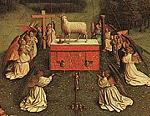City of arts: Ghent
Ghent is situated in the province of East Flanders, approximately halfway between Bruges and Brussels, where the rivers Schelde and Leie meet. Ghent may owe its name to the Celtic word for mouth or confluence - ganda. The town today has 230,000 inhabitants.
The place had been inhabited before, but in the 3rd century AD German attacks empty it out. In the 7th century St. Amandus founds an abbey there, and settlements are thrown up on the various river banks outside the town as we now know it. Owing to its flourishing textile industry (cloth, worsted) Ghent becomes Flanders' major city for a while.
Ghent is also the place of birth of Charles V (1500-1558), the Burgundy-Habsburg emperor who was the first to unite the Netherlands. In the 17th century, rivalry between the northern and southern Dutch provinces led to the blocking of the Antwerp port, which turned out bad for Ghent and Bruges. In both cities trade became almost impossible.
Art and Culture
Points of interest, in addition to the old city centre with the so-called Gravensteen - a 12th century stronghold and living quarters of the Flemish counts, reconstructed in the 19th century), the Belfort (Belfry), the Lakenhalle (Cloth Hall), the Graslei, and the Korenlei are:
 St. Baafs Cathedral, the oldest part of which dates back to the 12th century. Here you may find The Adoration of the Mystic Lamb, the famous polytych from 1432 by Hubert and Jan Van Eyck. But the cathedral boasts a wider selection of art, among others by Rubens.
St. Baafs Cathedral, the oldest part of which dates back to the 12th century. Here you may find The Adoration of the Mystic Lamb, the famous polytych from 1432 by Hubert and Jan Van Eyck. But the cathedral boasts a wider selection of art, among others by Rubens.- the Museum of Fine Art has a version of Hieronymus Bosch's Christ Carrying the Cross and work by other masters, including Il Tintoretto, Rubens (Flagellation), Frans Hals, James Ensor, Max Ernst, and René Magritte.
More information on Ghent may be found at the detailed website of the Ghent City Council.